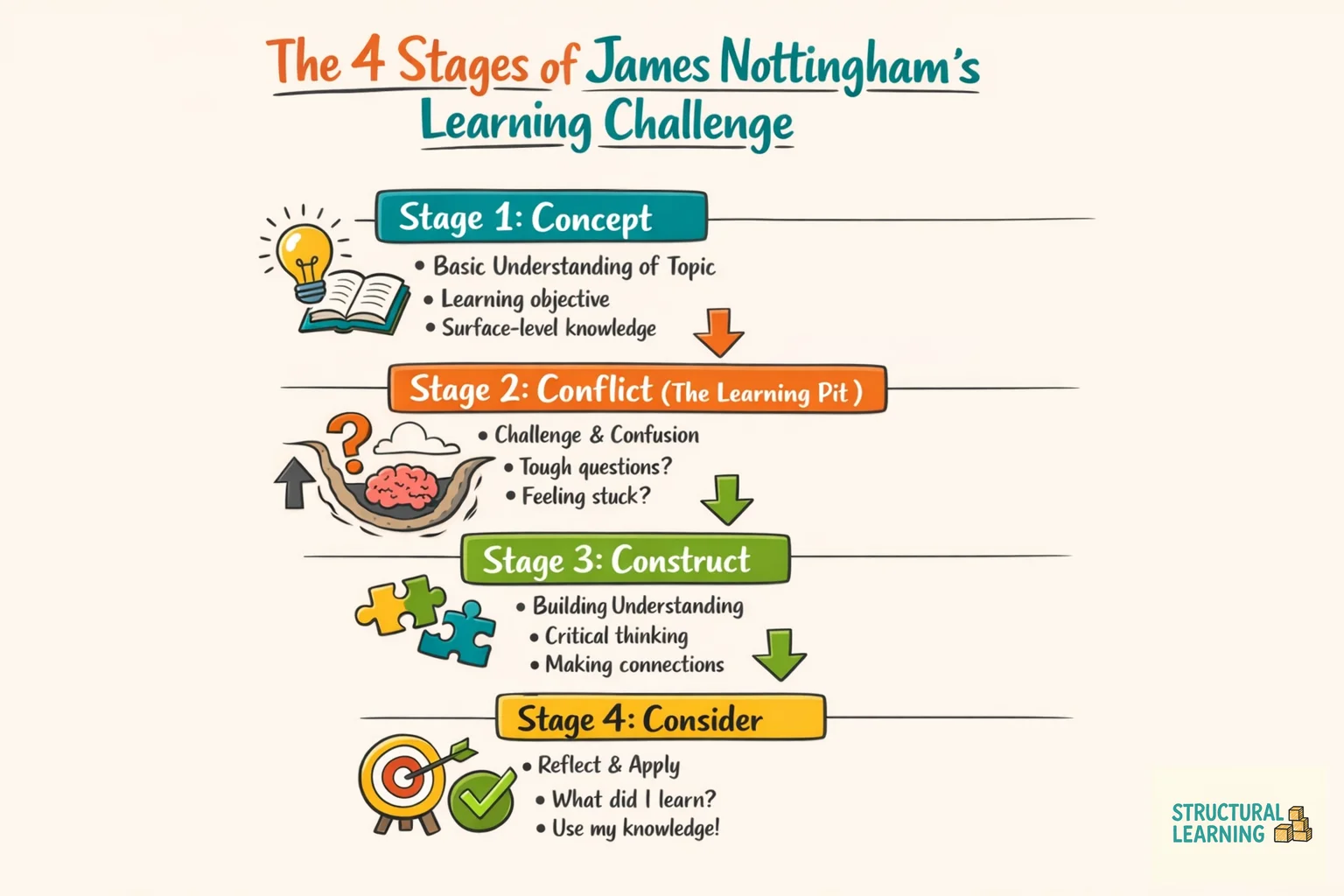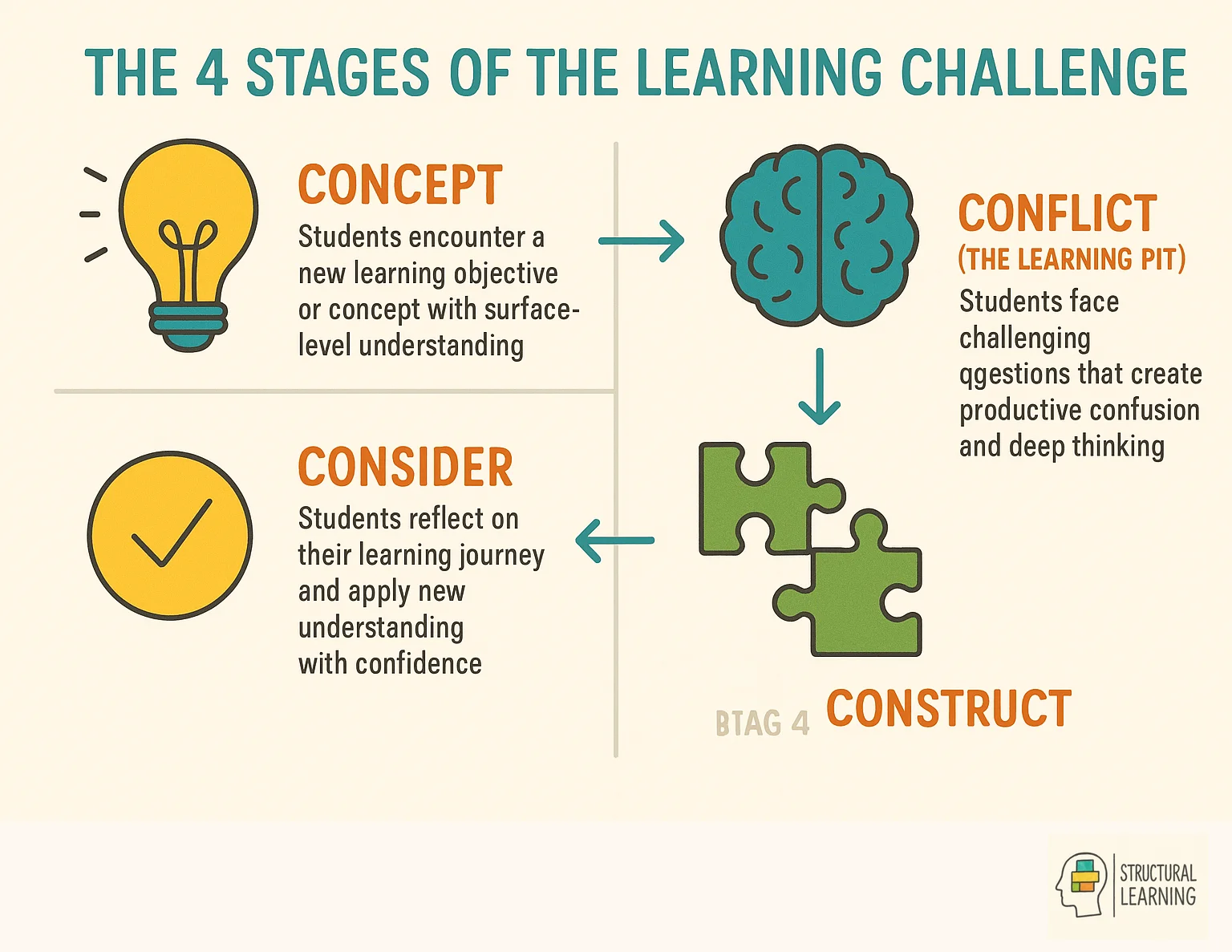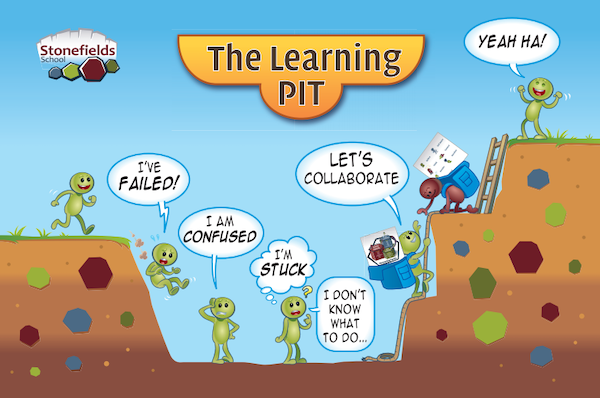The Learning Pit: a guide for teachers
Discover James Nottingham's Learning Pit model: a practical framework helping teachers guide students through productive struggle to deeper understanding.


Discover James Nottingham's Learning Pit model: a practical framework helping teachers guide students through productive struggle to deeper understanding.
The Learning Pit shows what real learning actually feels like. Created by James Nottingham in 2007, this model paints an honest picture of how we learn. Real progress starts with curiosity, dips into confusion and struggle, and then climbs back up to clarity and confidence.
At its core, the Learning Pit reminds us that genuine understanding doesn't happen on the surface. When learners meet ideas that challenge what they already know, they tumble into 'the pit'. This is an uncomfortable space where answers are unclear and thinking feels messy. But this discomfort sparks deeper thinking.

In the pit, students compare different ideas. They make connections between concepts and explain their thinking as they work towards understanding. This struggle builds habits that support lifelong learning: resilience, teamwork, and perseverance.

In 2025, schools focus more on critical thinking and adaptability. The Learning Pit remains as useful as ever. It helps students develop a growth mindset and see challenge as opportunity rather than threat.
Many schools use the Learning Pit as a shared language for discussing emotions and strategies linked to deep thinking. Used regularly, it supports questioning, independent learning, and critical thinking. Most importantly, stepping bravely into the pit and climbing out again helps students build confidence to tackle any future challenge.
Three key ideas to remember:
The learning pit is part of what James Nottingham called a learning challenge. This framework helps students in a classroom community to accept challenges, reflect, show resilience and create a growth mindset. Its main purpose is to develop thinking skills in learners and encourage them to ask questions and reflect.
A learning challenge moves students' understanding from surface level to deeper level. According to James Nottingham, children must ask complex questions about ideas presented to them. They must also question their own thinking. This leads to critical thinking skills in students. James Nottingham's teaching framework has four stages of Learning Challenge.

Stage 1. Concept: The Learning Challenge starts with a learning objective or concept. This objective may come from the teacher, conversation, media, classroom resources, observations or national curriculum. At this stage, the learner meets an issue or concept that they already have a basic idea or surface-level understanding of.
Stage 2. Conflict (Also called the learning pit): This is a stage of thinking conflict, where the learner enters the learning pit. At this stage, many questions about a challenging task are asked of the learner. It is a challenging stage where children must show deep thinking leading to deeper understanding.
The main part of the Learning Challenge is getting learners 'into the pit' by creating thinking conflict in students' minds. The purposeful creation of a problem makes the Learning Challenge useful for inquiry and challenge. Regular experience of thinking conflict helps create a Growth Mindset. Learning pits are useful places because they show that children have better understanding of the concept, and now have more complex questions about it.
Stage 3. Construct: At this stage, learners begin to construct meaning from their previous learning. Learners start to make connections between ideas while considering different options, viewpoints and defining cause and effect. At this stage, students find more clarity on the concept, alongside some degree of revelation. Students must experience a relatively uncomfortable conflict stage to develop much deeper understanding of the concept.
Stage 4. Consider: As students have already understood the concept more deeply, the clarity in stage 4 allows them to reflect on their learning process. This is a deep learning stage where the learner connects many concepts and answers. After considering how they moved from one stage to the other, they can use the same strategy to face other learning challenges. They can apply new understanding to another context. By doing this, learners create deep understanding of the importance of learning pits.

Getting a child into (and out of) the learning pit allows them to:
To speed up the learning process, students are taught how to respond to challenging learning. The 'learning pit' created by James Nottingham helps children understand the learning process. When students cannot understand new and difficult concepts, teachers can use this approach to encourage students to be resilient in their learning. It helps them apply deep thinking skills and a wide range of options to find answers.
Jill Nottingham, along with co-author James Nottingham, stated that the learning challenge is all about getting learners to question, wonder and challenge together. For them, learning experiences must create an 'intellectual problem' and a 'thinking wobble' so that learners can learn more.

Following are the main benefits of using the Learning Pit in student learning:
Developing thinking skills is key to success in the learning pit. These skills involve being aware of one's own thought processes and learning strategies. Students can adjust them as needed. Students who develop these skills are better equipped to tackle challenges and overcome obstacles in their learning journey.
Teachers can help students develop these skills by encouraging them to reflect on their learning. They can ask questions that promote critical thinking and provide opportunities for self-assessment. By building these thinking skills, teachers can help their students take ownership of their learning and become lifelong learners.

In a society where students are used to getting things done quickly, it can be difficult to teach students how to overcome challenges. Today's students have technology, access to learning books and other resources. Easy access to such educational resources is likely to change children's attitudes and help them learn anything without fear of failure.
In this situation, it can be challenging for teachers to keep students motivated to build complex understanding. This is especially true when students can get frustrated, find something as impossible, feel they've failed, or have a habit of giving up soon. In those times of distress, the learning challenge helps students develop a growth mindset and helps them get comfortable with being uncomfortable.
Active learning is a key part in helping students overcome challenges and develop a growth mindset. By engaging students in hands-on activities and encouraging them to ask questions and explore different viewpoints, teachers can help students build complex understanding. They develop the skills they need to navigate the learning pit.
Active learning also helps keep students motivated and engaged. They actively participate in the learning process and take ownership of their own learning. Ultimately, by embracing the learning pit and using active learning strategies, students can develop the resilience and perseverance they need to succeed in school and beyond.

The Learning Pit model shows that deep learning happens when students experience thinking conflict, grapple with uncertainty, and ultimately build new understanding through challenge and reflection. The following studies explore the key principles behind the Learning Pit. They highlight the importance of productive struggle, feedback, and guided support in building deeper learning.
1. Dweck (2006) - Mindset: The New Psychology of Success
This foundational study on growth mindset supports the Learning Pit principle that struggle and challenge are needed for developing resilience and deeper understanding. Dweck's work showed that students who embraced challenge and effort as part of the learning process showed greater perseverance and learning gains compared to those who avoided challenges or saw struggle as a sign of failure.
Key Principle: Embracing thinking conflict as part of deep learning and personal growth.
2. Vygotsky (1978) - Mind in Society: The Development of Higher Psychological Processes
Vygotsky's concept of the Zone of Proximal Development (ZPD) strongly matches the Learning Pit Model. It shows that learning happens most effectively when students are pushed slightly beyond their comfort zone. They need support to navigate uncertainty but ultimately develop deeper understanding through social interaction and guided help.
Key Principle: Learning happens when students grapple with new concepts at the edge of their current abilities.
3. Bjork & Bjork (1992) - Desirable Difficulties in Learning
This study showed that introducing desirable difficulties (tasks that are challenging but achievable) improves long-term memory and understanding. Nottingham's Learning Pit mirrors this principle by encouraging students to struggle productively before achieving clarity.
Key Principle: Productive struggle improves memory, understanding, and thinking flexibility.
4. Hattie & Timperley (2007) - The Power of Feedback
This research highlighted the importance of feedback during struggle. This is a core part of the Learning Pit process. Effective feedback helps learners understand their position within the struggle (in the pit) and provides guidance to move toward deeper understanding.
Key Principle: Timely, specific feedback is needed for guiding students through thinking conflict.
5. Perkins (1999) - The Many Faces of Constructivism
Perkins' exploration of constructivist learning ties directly into the Learning Pit. It shows that learners build meaning when they actively engage with challenging material, reconsider their mistakes, and develop new understandings through reflection and peer discussion.
Key Principle: Deep learning occurs when students confront thinking conflict and revise existing ideas.
The Learning Pit shows what real learning actually feels like. Created by James Nottingham in 2007, this model paints an honest picture of how we learn. Real progress starts with curiosity, dips into confusion and struggle, and then climbs back up to clarity and confidence.
At its core, the Learning Pit reminds us that genuine understanding doesn't happen on the surface. When learners meet ideas that challenge what they already know, they tumble into 'the pit'. This is an uncomfortable space where answers are unclear and thinking feels messy. But this discomfort sparks deeper thinking.

In the pit, students compare different ideas. They make connections between concepts and explain their thinking as they work towards understanding. This struggle builds habits that support lifelong learning: resilience, teamwork, and perseverance.

In 2025, schools focus more on critical thinking and adaptability. The Learning Pit remains as useful as ever. It helps students develop a growth mindset and see challenge as opportunity rather than threat.
Many schools use the Learning Pit as a shared language for discussing emotions and strategies linked to deep thinking. Used regularly, it supports questioning, independent learning, and critical thinking. Most importantly, stepping bravely into the pit and climbing out again helps students build confidence to tackle any future challenge.
Three key ideas to remember:
The learning pit is part of what James Nottingham called a learning challenge. This framework helps students in a classroom community to accept challenges, reflect, show resilience and create a growth mindset. Its main purpose is to develop thinking skills in learners and encourage them to ask questions and reflect.
A learning challenge moves students' understanding from surface level to deeper level. According to James Nottingham, children must ask complex questions about ideas presented to them. They must also question their own thinking. This leads to critical thinking skills in students. James Nottingham's teaching framework has four stages of Learning Challenge.

Stage 1. Concept: The Learning Challenge starts with a learning objective or concept. This objective may come from the teacher, conversation, media, classroom resources, observations or national curriculum. At this stage, the learner meets an issue or concept that they already have a basic idea or surface-level understanding of.
Stage 2. Conflict (Also called the learning pit): This is a stage of thinking conflict, where the learner enters the learning pit. At this stage, many questions about a challenging task are asked of the learner. It is a challenging stage where children must show deep thinking leading to deeper understanding.
The main part of the Learning Challenge is getting learners 'into the pit' by creating thinking conflict in students' minds. The purposeful creation of a problem makes the Learning Challenge useful for inquiry and challenge. Regular experience of thinking conflict helps create a Growth Mindset. Learning pits are useful places because they show that children have better understanding of the concept, and now have more complex questions about it.
Stage 3. Construct: At this stage, learners begin to construct meaning from their previous learning. Learners start to make connections between ideas while considering different options, viewpoints and defining cause and effect. At this stage, students find more clarity on the concept, alongside some degree of revelation. Students must experience a relatively uncomfortable conflict stage to develop much deeper understanding of the concept.
Stage 4. Consider: As students have already understood the concept more deeply, the clarity in stage 4 allows them to reflect on their learning process. This is a deep learning stage where the learner connects many concepts and answers. After considering how they moved from one stage to the other, they can use the same strategy to face other learning challenges. They can apply new understanding to another context. By doing this, learners create deep understanding of the importance of learning pits.

Getting a child into (and out of) the learning pit allows them to:
To speed up the learning process, students are taught how to respond to challenging learning. The 'learning pit' created by James Nottingham helps children understand the learning process. When students cannot understand new and difficult concepts, teachers can use this approach to encourage students to be resilient in their learning. It helps them apply deep thinking skills and a wide range of options to find answers.
Jill Nottingham, along with co-author James Nottingham, stated that the learning challenge is all about getting learners to question, wonder and challenge together. For them, learning experiences must create an 'intellectual problem' and a 'thinking wobble' so that learners can learn more.

Following are the main benefits of using the Learning Pit in student learning:
Developing thinking skills is key to success in the learning pit. These skills involve being aware of one's own thought processes and learning strategies. Students can adjust them as needed. Students who develop these skills are better equipped to tackle challenges and overcome obstacles in their learning journey.
Teachers can help students develop these skills by encouraging them to reflect on their learning. They can ask questions that promote critical thinking and provide opportunities for self-assessment. By building these thinking skills, teachers can help their students take ownership of their learning and become lifelong learners.

In a society where students are used to getting things done quickly, it can be difficult to teach students how to overcome challenges. Today's students have technology, access to learning books and other resources. Easy access to such educational resources is likely to change children's attitudes and help them learn anything without fear of failure.
In this situation, it can be challenging for teachers to keep students motivated to build complex understanding. This is especially true when students can get frustrated, find something as impossible, feel they've failed, or have a habit of giving up soon. In those times of distress, the learning challenge helps students develop a growth mindset and helps them get comfortable with being uncomfortable.
Active learning is a key part in helping students overcome challenges and develop a growth mindset. By engaging students in hands-on activities and encouraging them to ask questions and explore different viewpoints, teachers can help students build complex understanding. They develop the skills they need to navigate the learning pit.
Active learning also helps keep students motivated and engaged. They actively participate in the learning process and take ownership of their own learning. Ultimately, by embracing the learning pit and using active learning strategies, students can develop the resilience and perseverance they need to succeed in school and beyond.

The Learning Pit model shows that deep learning happens when students experience thinking conflict, grapple with uncertainty, and ultimately build new understanding through challenge and reflection. The following studies explore the key principles behind the Learning Pit. They highlight the importance of productive struggle, feedback, and guided support in building deeper learning.
1. Dweck (2006) - Mindset: The New Psychology of Success
This foundational study on growth mindset supports the Learning Pit principle that struggle and challenge are needed for developing resilience and deeper understanding. Dweck's work showed that students who embraced challenge and effort as part of the learning process showed greater perseverance and learning gains compared to those who avoided challenges or saw struggle as a sign of failure.
Key Principle: Embracing thinking conflict as part of deep learning and personal growth.
2. Vygotsky (1978) - Mind in Society: The Development of Higher Psychological Processes
Vygotsky's concept of the Zone of Proximal Development (ZPD) strongly matches the Learning Pit Model. It shows that learning happens most effectively when students are pushed slightly beyond their comfort zone. They need support to navigate uncertainty but ultimately develop deeper understanding through social interaction and guided help.
Key Principle: Learning happens when students grapple with new concepts at the edge of their current abilities.
3. Bjork & Bjork (1992) - Desirable Difficulties in Learning
This study showed that introducing desirable difficulties (tasks that are challenging but achievable) improves long-term memory and understanding. Nottingham's Learning Pit mirrors this principle by encouraging students to struggle productively before achieving clarity.
Key Principle: Productive struggle improves memory, understanding, and thinking flexibility.
4. Hattie & Timperley (2007) - The Power of Feedback
This research highlighted the importance of feedback during struggle. This is a core part of the Learning Pit process. Effective feedback helps learners understand their position within the struggle (in the pit) and provides guidance to move toward deeper understanding.
Key Principle: Timely, specific feedback is needed for guiding students through thinking conflict.
5. Perkins (1999) - The Many Faces of Constructivism
Perkins' exploration of constructivist learning ties directly into the Learning Pit. It shows that learners build meaning when they actively engage with challenging material, reconsider their mistakes, and develop new understandings through reflection and peer discussion.
Key Principle: Deep learning occurs when students confront thinking conflict and revise existing ideas.